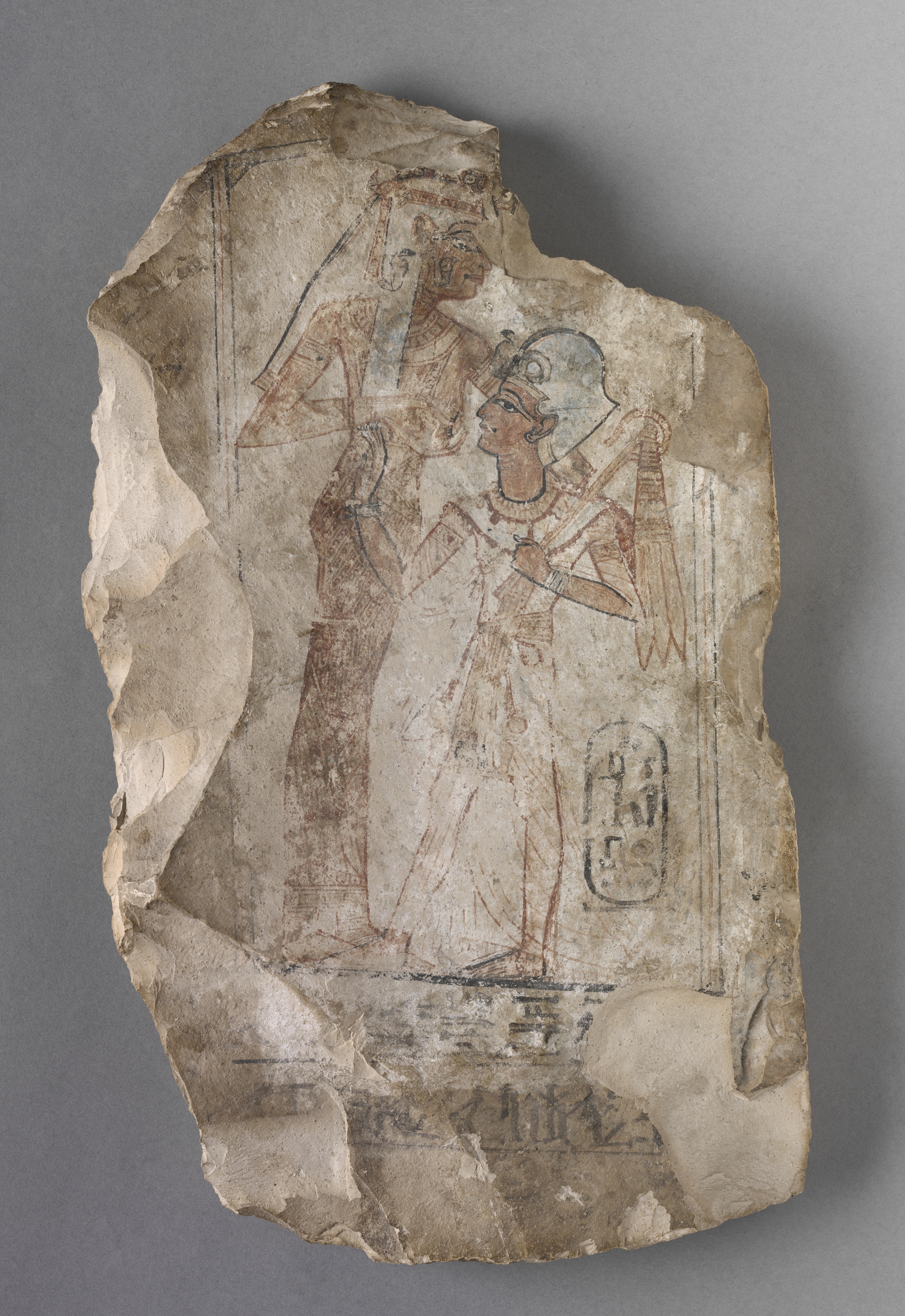The Cleveland Museum of Art
Collection Online as of April 19, 2024

Ostracon: Ramesses II Suckled by a Goddess
c. 1279–1213 BCE
(1540–1069 BCE), Dynasty 19, reign of Ramesses II (1279–1213 BCE)
Overall: 31.2 x 18.2 x 3.3 cm (12 5/16 x 7 3/16 x 1 5/16 in.)
Location: 107 Egyptian
Did You Know?
The artisans who carved the tombs in the cemeteries lived in a tiny community not far from their workplace.Description
Ostraca (singular, ostracon) are natural limestone flakes, common to the region of Thebes. The ancient Egyptians who lived there, particularly the artisans of the royal tombs, used them extensively as writing or drawing surfaces, both for practice and for instruction. Some are almost finished works of art; others are clearly sketches. Whether passing idle time or practicing their technique, these pieces provide a rare look at an ancient artist at work. This ostracon is decorated with a scene of the king suckled by a goddess. Although his body is that of an adult, the king (identified by the inscriptions as Ramesses II) appears child size. The goddess wears a long garment of vulture's wings--she could be any of a number of protective mother or sky goddesses.- Private Collection, Baltimore, MD1965Garrison Forest School, Baltimore, MDNovember 24-25, 1987(Sale: Sotheby's, New York, 24-25 November 1987, no. 47)1987-The Cleveland Museum of Art, Cleveland, OH
- Brunner-Traut, Emma. Die altägyptischen Scherbenbilder (Bildostraka) der Deutschen Museen und Sammlungen. Wiesbaden: Franz Steiner, 1956.Sotheby's (Firm). Antiquities and Islamic Works of Art, with Property from the Joseph Ternbach Collection. 1987. no. 47, pp. 46-47Turner, Evan H. "The Year in Review for 1987." The Bulletin of the Cleveland Museum of Art 75, no. 2 (1988): 30-71. Reproduced: p. 46 25160017The Cleveland Museum of Art. Handbook of the Cleveland Museum of Art. Cleveland, OH: The Cleveland Museum of Art, 1991. Reproduced: p. 4 archive.orgJ. Paul Getty Museum, and Getty Conservation Institute. In the Tomb of Nefertari: Conservation of the Wall Paintings. [Malibu, Calif.]: J. Paul Getty Museum, 1992. no. 21Capel, Anne K., and Glenn Markoe, eds. Mistress of the House, Mistress of Heaven: Women in Ancient Egypt. New York, NY: Hudson Hills Press, 1996. no. 51, Reproduced: p. 118Berman, Lawrence M., and Kenneth J. Bohač. Catalogue of Egyptian Art: The Cleveland Museum of Art. Cleveland, OH: Cleveland Museum of Art, 1999 Mentioned: p. 248-249; Reproduced: p. 248-249, Color p. 57: Mentioned: p. 248-249Ziegler, Christiane, ed. The Pharaohs. Milan: Bompiani, 2002. Mentioned and Reproduced: p. 403Hays, Christopher B. "Egyptian Goddess Mut in Iron Age Palestine" Journal of Near Eastern Studies, Vol. 71, No. 2 (October 2012). fig. 1, p. 301Vandenbeusch, Marie, Aude Semat, and Margaret Maitland. Pharaoh: King of Ancient Egypt. New Haven and London: Yale University Press, 2016. Mentioned: p.53; Reproduced: p. 52
- Pharaoh: King of Ancient Egypt. The Cleveland Museum of Art, Cleveland, OH (organizer) (March 13-June 12, 2016).I Faraoni. Palazzo Grassi spa, 30124 Venice, Italy (organizer) (September 8, 2002-July 6, 2003).Mistress of the House, Mistress of Heaven: Women in Ancient Egypt . The Cincinnati Art Museum (organizer) (October 19, 1996-January 15, 1997); The Brooklyn Museum (February 20-May 18, 1997).In the Tomb of Nefertari: Conservation of the Wall Paintings. The J. Paul Getty Museum, Malibu, CA (12 November 1992-21 February 1993).The Year in Review for 1987. The Cleveland Museum of Art, Cleveland, OH (organizer) (February 24-April 17, 1988).
- {{cite web|title=Ostracon: Ramesses II Suckled by a Goddess|url=false|author=|year=c. 1279–1213 BCE|access-date=19 April 2024|publisher=Cleveland Museum of Art}}
Source URL:
https://www.clevelandart.org/art/1987.156